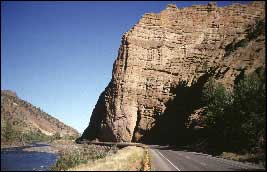















Successes in Stewardship: July 2003 |
|---|

|
Federal Highway Administration
July 2003
Committed to Excellence: Successful State Approaches to Implementing Environmental Commitments

Successful implementation of environmental commitments described in the documents required by the National Environmental Policy Act (NEPA) or related to specific resource permits is a critical aspect of the transportation project development process. Not only is it the Federal Highway Administration's (FHWA) responsibility to assure that these measures are implemented, but this implementation is also a key element of exhibiting environmental stewardship. In recent years, the greater emphasis placed on making the transportation decisionmaking and environmental review processes more effective and efficient has only highlighted the importance of guaranteeing implementation of these commitments.
In the fall of 2002, FHWA's Office of Project Development and Environmental Review sponsored the Domestic Scan Tour on Environmental Commitment Implementation (Domestic Scan) in recognition of the importance of this highly visible area to environmental stewardship and streamlining activities. The Domestic Scan focused on successful practices and procedures for following through on environmental commitments during and after the NEPA process. The Domestic Scan team, which was comprised of members with a wide variety of expertise, visited a diverse cross-section of state DOTs. The team observed that regardless of the size or geographical conditions of the transportation programs, these states were dedicated to ensuring the implementation of environmental commitments. While many of the methodologies and techniques the visited states use are not new, they all rely on good communication and the principles of environmental stewardship. These and other best management practices are presented in the report "Environmental Commitment Implementation: Innovative and Successful Approaches." The report is intended to assist states, FHWA Divisions, environmental resource agencies, and the private sector in successfully complying with environmental commitments through project design, development, construction, and maintenance.
| For a copy of "Environmental Commitment Implementation: Innovative and Successful Approaches," contact Ruth Rentch at (202) 366-2034 or Ruth.Rentch@fhwa.dot.gov. |
Lessons Learned
|
Best Management Practices of the Seven Participating States The seven participating states — Colorado, Indiana, Kentucky, New Jersey, New York, Texas, and Wyoming — showcased a variety of tools to meet environmental commitments successfully and to ensure follow-through. The procedures, tracking systems, guidance materials, and other tools described in the Domestic Scan report and in the table below are a sample of the environmental commitment compliance activities that state DOTs and other transportation agencies are using throughout the country. |
| Best Practice | State Example |
|---|---|
| Environmental Ethic/Stewardship | The Governor of New York and the Commissioner of the New York State Department of Transportation (NYSDOT) introduced an initiative empowering all NYSDOT employees to include environmental aspects in their jobs. |
| Staffing | The Wyoming Department of Transportation created an environmental coordinator position to ensure that environmental issues are resolved during construction and maintenance in all of its districts. |
| Training Opportunities | The Indiana Department of Transportation (INDOT) mandates that its consultants be trained and certified by INDOT on unique environmental aspects, including NEPA. |
| Guidance Documents | The Texas Department of Transportation (TxDOT) will soon be issuing two pocket guides addressing environmental issues for field personnel. Both guides summarize environmental compliance issues that may be encountered during construction or maintenance, present advice on how to handle unforeseen issues, and recommend where to seek assistance. |
| Commitment Assurance | The Kentucky Transportation Cabinet's "Communicating All Promises" approach tracks and demonstrates follow-through on all commitments and improves communication among all parties involved in the transportation process. |
| Tracking Mechanisms | The New Jersey Department of Transportation developed a comprehensive Cultural Resource Commitments List to improve its relationship with the State Historic Preservation Office. The list contains project descriptions, program and project managers, target dates for activities, estimated mitigation costs, and progress status. |
| Public Involvement | TxDOT's public involvement program utilized both traditional methods and innovative bilingual approaches on its Kelly Parkway Corridor Study in San Antonio, a project that impacts a low-income, Spanish-speaking minority community. TxDOT located a public involvement office inside the community, developed a public involvement website, and conducted ongoing stakeholder meetings and public education workshops. |
| Interagency Coordination | The Colorado Department of Transportation created the Council of Resource Agencies (Council) to address project commitments and discuss resource agency concerns prior to a project's construction. The U.S. Forest Service, U.S. Army Corps of Engineers, U.S. Environmental Protection Agency, Bureau of Land Management, and U.S. Fish and Wildlife Service sit on the Council. |
Who was Involved in the Domestic Scan?The Domestic Scan team was designed to be a cross-functional group with expertise in areas ranging from transportation engineering to environmental protection. Members came from the following agencies and organizations:
|
Contact InformationRuth Rentch |
|
"Successes in Stewardship" is a Federal Highway Administration newsletter highlighting current environmental streamlining practices from around the country. To subscribe, call (617) 494-6352 or email esnewsletter@volpe.dot.gov. |
